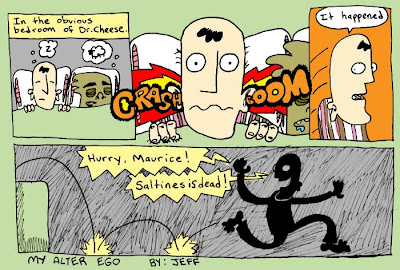
Tuesday, October 28, 2008
Influence
The work of Syd Hoff continues my articles on my artistic influences.
Children's books have played a big role in my life. Beginning with my mom reading stories to me when I was young, to learning to read, to going through my undergraduate degree in Elementary Education, to my job now working with children, and continuing with the anticipation of my own child's birth in May, I have never lost my enthusiasm and excitement for a really good kid's book. They're fun to read, and the art is often top notch.
Syd Hoff made a career out of teaching kids how to read through the 60+ volumes in the HarperCollins "I Can Read" series for beginning readers beginning in the '50s. These books stand out in my mind as some of my favorites when I was young. Most likely because they featured talking animals, or cavemen, or dinosaurs, or other characters I found of interest (and still do.)

Hoff's art is so amazing in its simplicity. With only a few lines he is able to convey so much. I also enjoy how fluid his art is, with almost no harsh or jagged lines. You can almost see his brush moving across the page. All of this works together to create a very clean, happy and energetic page. You can't help but smile when you read a book by Syd.

Hoff was also a cartoonist for The New Yorker, who published his work when he was only 18. Hoff worked in the single panel structure, and as you can see in the two panels I have posted below (which feature no captions here), his art can say so much even without words. As mentioned I do not have the captions to go along with these panels, but I highly recommend you visit Syd Hoff's site, which features these panels as well as many more. You can also learn quiet a bit more about the man who helped so many kids learn to read.


Children's books have played a big role in my life. Beginning with my mom reading stories to me when I was young, to learning to read, to going through my undergraduate degree in Elementary Education, to my job now working with children, and continuing with the anticipation of my own child's birth in May, I have never lost my enthusiasm and excitement for a really good kid's book. They're fun to read, and the art is often top notch.
Syd Hoff made a career out of teaching kids how to read through the 60+ volumes in the HarperCollins "I Can Read" series for beginning readers beginning in the '50s. These books stand out in my mind as some of my favorites when I was young. Most likely because they featured talking animals, or cavemen, or dinosaurs, or other characters I found of interest (and still do.)

Hoff's art is so amazing in its simplicity. With only a few lines he is able to convey so much. I also enjoy how fluid his art is, with almost no harsh or jagged lines. You can almost see his brush moving across the page. All of this works together to create a very clean, happy and energetic page. You can't help but smile when you read a book by Syd.

Hoff was also a cartoonist for The New Yorker, who published his work when he was only 18. Hoff worked in the single panel structure, and as you can see in the two panels I have posted below (which feature no captions here), his art can say so much even without words. As mentioned I do not have the captions to go along with these panels, but I highly recommend you visit Syd Hoff's site, which features these panels as well as many more. You can also learn quiet a bit more about the man who helped so many kids learn to read.


Monday, October 27, 2008
Sunday, October 26, 2008
Get Out and Vote!

This amazing smear campaign urging us all to vote Smarrots was brought to you by the incorrigable Phillip Ginn.
Thursday, October 23, 2008
Influence
Since I'm currently in the most labor-intensive semester of my Master's degree (1 week = 40 hours work, 10+ hours interning at elementary school, 16 hours on weekends at hospital's psych unit) I haven't found much time to work on My Alter Ego. The ending to the Skomolii saga is coming, just probably not until mid-December. So I thought I would take a small break and instead post some semi-regular articles on my artistic influences.
Let's begin with the great Charles M. Schulz.

Schulz's big break was a small comic strip called Peanuts. Beginning in 1950 and running until 2000, the strip explored the isolation, depression, and just plain mean spirit of childhood. Schulz, himself, has said the strip was about unrequited love. Charlie Brown could never speak to the little red head girl, Schroeder would never return Lucy's affection, and the kid's baseball team could never win a game. If these things were to happen, the strip would no longer be funny.
Schulz may have been the hardest working cartoonist. He never took a day off in 50 years of drawing the comic strip, excepting in 1999 when he was placed in the hospital after being diagnosed with colon cancer. Shortly after receiving treatment Schulz was back at the drawing table, however, with a shakier drawing hand. In the end the comic strip would outlive its creator by one day. A symbolic ending for a man who loved what he did, and dedicated his life to perfecting his art.
A wonderful autobiography, Schulz and Peanuts, came out last year. I recommend it for anyone interested in reading more about Schulz's life and his own battle with depression. Fantagraphics is also reprinting all of the old Peanuts strips into really great box sets. In my opinion, nobody is able to draw the innocence of childhood as honestly and accurately as Schulz.
Having dealt with a great deal of anxiety and isolation in my own youth I connect with Schulz's comic on a personal level. Charlie Brown makes me feel not so alone. So much so that he's been tattooed on my right calf. I've also said that K10 and I are what would have happened if Charlie Brown and Lucy Van Pelt grew up and got married.

Let's begin with the great Charles M. Schulz.

Schulz's big break was a small comic strip called Peanuts. Beginning in 1950 and running until 2000, the strip explored the isolation, depression, and just plain mean spirit of childhood. Schulz, himself, has said the strip was about unrequited love. Charlie Brown could never speak to the little red head girl, Schroeder would never return Lucy's affection, and the kid's baseball team could never win a game. If these things were to happen, the strip would no longer be funny.
Schulz may have been the hardest working cartoonist. He never took a day off in 50 years of drawing the comic strip, excepting in 1999 when he was placed in the hospital after being diagnosed with colon cancer. Shortly after receiving treatment Schulz was back at the drawing table, however, with a shakier drawing hand. In the end the comic strip would outlive its creator by one day. A symbolic ending for a man who loved what he did, and dedicated his life to perfecting his art.
A wonderful autobiography, Schulz and Peanuts, came out last year. I recommend it for anyone interested in reading more about Schulz's life and his own battle with depression. Fantagraphics is also reprinting all of the old Peanuts strips into really great box sets. In my opinion, nobody is able to draw the innocence of childhood as honestly and accurately as Schulz.
Having dealt with a great deal of anxiety and isolation in my own youth I connect with Schulz's comic on a personal level. Charlie Brown makes me feel not so alone. So much so that he's been tattooed on my right calf. I've also said that K10 and I are what would have happened if Charlie Brown and Lucy Van Pelt grew up and got married.

Wednesday, October 15, 2008
Saturday, October 4, 2008
Subscribe to:
Posts (Atom)



